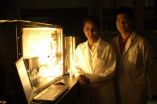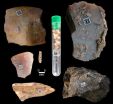(Press-News.org) CHAMPAIGN, Ill. — University of Illinois materials scientists have developed a simple, generalizable technique to fabricate complex structures that assemble themselves.
Their advance, published in the Jan. 20 issue of Nature, utilizes a new class of self-assembling materials that they developed. The team demonstrated that they can produce a large, complex structure – an intricate lattice – from tiny colloidal particles called triblock Janus spheres.
"This is a big step forward in showing how to make non-trivial, non-obvious structures from a very simple thing," said Steve Granick, Founder Professor of Engineering at the University of Illinois and a professor of materials science and engineering, chemistry, and physics. "People know a lot about how to do it with molecules – soaps for example – but scientists and engineers know very little about how to make it happen with particles. Particles are very different from molecules: They're big, they're nonflexible, and they have lots of critically different materials properties."
Much of the work to date in making complicated structures from colloidal particles has been done through computer simulation. Researchers model complicated designs built of highly complicated particles.
However, creating complicated building blocks for experimental use is difficult. By contrast, the triblock Janus spheres' elegant simplicity makes them ideal for real-world manufacture.
"It was conceptually challenging to fabricate a complex porous material from a simple design, especially in the field of colloidal particles," said graduate student Qian Chen, a co-author of the paper. "Here, we achieve that with really easy designs that we can use in experiments."
Granick's group is well-known for its work with Janus particles. Named for the dual-natured Roman god, Janus particles have two sides or segments of different surface chemistry. Having explored spheres with two different-natured halves, Chen had the idea to make spheres with three "stripes" of reactivity, dubbed triblock Janus spheres. The center band is charged, while the poles are hydrophobic, or water-adverse.
"After many experiments with Janus particles, I wanted to see if adding one more segment would introduce more surprises," Chen said. "Usually in colloid science people use particles that have a uniform surface chemistry. But for this particle, it's like a block polymer. It has three segments of chemistry."
In a salt-water solution, the hydrophobic poles are drawn together, while the charged equators repel one another. As a result, the spheres form a complex lattice where only the poles are in contact with one another. The hydrophobic polar caps are large enough to come into contact with two other spheres. This causes the spheres to arrange into a formation like a six-pointed star, creating a sheet of delicate lace.
Such porous sheets of schizoid particles, hydrophobic and hydrophilic at the same time, could have applications as specialized filters.
"It's like a better soap," Granick said. "Just as soap is very good at dissolving both fats and water-soluble things, our new lacy lattice can also filter out both water-soluble and oil-soluble matter. We have this wonderful self-produced lacy structure that's oil-loving and water-loving at different parts in a periodic array."
The team could apply their simple particle design to fabricate other planar laces. Adjusting the size of the spheres or the proportion of the bands could lead to other lattice patterns or tuned pore sizes. In addition, further exploration of triblock spheres and other Janus particles could open doors to a broad area of self-assembly of complex structures from simple materials.
"Someday maybe we could have a soup of different components, remove some of it, and there would be a microelectronic chip," Granick said. "It's a brand new area. The materials are so different that the structures that they form will be different."
INFORMATION:
Research scientist Sung Chul Bae also was a co-author of the paper. The U.S. Department of Energy sponsored this work through the Frederick Seitz Materials Research Laboratory at the U. of I.
Editor’s note: To reach Steve Granick, call 217-333-5720; e-mail: sgranick@illinois.edu.
Triblock spheres provide a simple path to complex structures
2011-01-20
ELSE PRESS RELEASES FROM THIS DATE:
Survey reveals potential innovation gap in the US
2011-01-20
Cambridge, Mass., January 19, 2011 – Invention and innovation are essential to remaining globally competitive, and a new survey shows an untapped group of potential inventors in the U.S. The 2011 Lemelson-MIT Invention Index , announced today, indicates that American women ages 16 – 25 possess many characteristics necessary to become inventors, such as creativity, interest in science and math, desire to develop altruistic inventions, and preference for working in groups or with mentors – yet they still do not see themselves as inventive. Young men in the same age group ...
Parental divorce linked to suicidal thoughts
2011-01-20
TORONTO, ON –Adult children of divorce are more likely to have seriously considered suicide than their peers from intact families, suggests new research from the University of Toronto
In a paper published online this week in the journal Psychiatry Research, investigators examined gender specific differences among a sample of 6,647 adults, of whom 695 had experienced parental divorce before the age of 18. The study found that men from divorced families had more than three times the odds of suicidal ideation in comparison to men whose parents had not divorced. Adult daughters ...
Case Western Reserve and Athersys show regenerative benefit of MultiStem after spinal cord injury
2011-01-20
Case Western Reserve University School of Medicine and Athersys, Inc. (NASDAQ: ATHX) announced a joint scientific study on spinal cord injury will be published today in the January issue of the Journal of Neuroscience. The study, by leading researchers from the Department of Neurosciences at the School of Medicine and scientists at Athersys, presents data supporting the potential therapeutic benefit of Athersys' MultiStem® program for spinal cord injury. Researchers observed that administration of Multipotent Adult Progenitor Cells (MAPC) following spinal cord injury in ...
New reactor paves the way for efficiently producing fuel from sunlight
2011-01-20
PASADENA, Calif.—Using a common metal most famously found in self-cleaning ovens, Sossina Haile hopes to change our energy future. The metal is cerium oxide—or ceria—and it is the centerpiece of a promising new technology developed by Haile and her colleagues that concentrates solar energy and uses it to efficiently convert carbon dioxide and water into fuels.
Solar energy has long been touted as the solution to our energy woes, but while it is plentiful and free, it can't be bottled up and transported from sunny locations to the drearier—but more energy-hungry—parts ...
Malaria parasite caught red-handed invading blood cells
2011-01-20
Australian scientists using new image and cell technologies have for the first time caught malaria parasites in the act of invading red blood cells. The researchers, from the Walter and Eliza Hall Institute in Melbourne, Australia, and the University of Technology, Sydney (UTS), achieved this long-held aim using a combination of electron, light and super resolution microscopy, a technology platform new to Australia.
The detailed look at what occurs as the parasite burrows through the walls of red blood cells provides new insights into the molecular and cellular events ...
Fears of Ontario pharmacy shortage after slashed generic drug prices unfounded: UBC research
2011-01-20
A University of British Columbia study shows that there are enough pharmacies situated throughout Ontario communities to absorb many closures without negatively affecting geographical accessibility for residents. The research suggests concerns that reducing generic pricing could result in pharmacy shortages are unfounded.
Last summer, the Ontario government cut the price of generic drugs by half – to approximately 25 per cent of the equivalent brand – leading to heated discussions on the sustainability of existing pharmacies. Some pharmacy chains claimed they might be ...
Man, volcanoes and the sun have influenced Europe's climate over recent centuries
2011-01-20
An International research team has discovered that seasonal temperatures in Europe, above all in winter, have been affected over the past 500 years by natural factors such as volcanic eruptions and solar activity, and by human activities such as the emission of greenhouse gases. The study, with Spanish involvement, could help us to better understand the dynamics of climate change.
Up until now, it was thought that Europe's climate prior to 1900 was barely affected by external factors, but now a group of scientists has shown that natural phenomena such as volcanic eruptions ...
Unfolding pathogenesis in Parkinson's
2011-01-20
The study, published in the Journal of Clinical Investigation, reveals that damaged alpha-synuclein proteins (which are implicated in Parkinson's disease) can spread in a 'prion-like' manner, an infection model previously described for diseases such as BSE (mad cow disease).
"This is a significant step forward in our understanding of the potential role of cell-to-cell transfer of alpha-synuclein in Parkinson's disease pathogenesis and we are very excited about the findings", says Professor Patrik Brundin at Lund University, Sweden, who led a team of investigators from ...
Neiker-Tecnalia makes progress in detection and prevention of infection by visna maedi virus
2011-01-20
Researchers at Neiker-Tecnalia (the Basque Institute for Agricultural Research and Development) have undertaken a study on the epidemiology and diagnosis of infection by visna/maedi virus. This is a virus that affects sheep herds causing chronic interstitial pneumonia, mastitis and neurological disorders. The study confirmed that horizontal transmission (direct contact between infected animals) of the virus is the most likely path of infection, rather than vertical transmission (from infected suckling milk or colostrum). Since there is no current effective treatment against ...
Data matrix codes used to catalogue archaeological heritage
2011-01-20
The research team at the Centre for the Studies of Archaeological and Prehistoric Heritage (CEPAP) of Universitat Autònoma de Barcelona (UAB) have implemented an innovative system to register archaeological artefacts which eliminates problems in manual markings, such as errors in writing or erosion of data. The system, based on direct labelling using bi-dimensional data matrix (DM) codes, has been used by the CEPAP team during two years, in which numerous artefacts and bone remains from sites in Spain and Africa were registered.
The marking of archaeological material, ...





